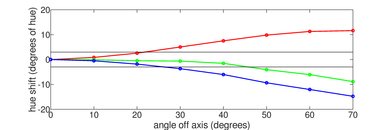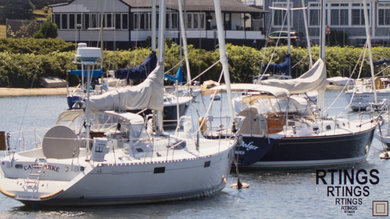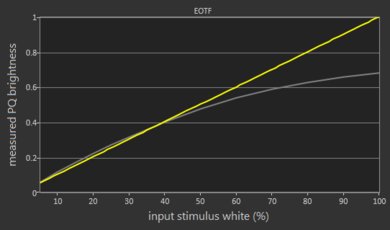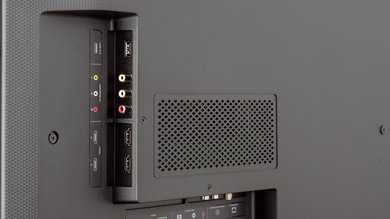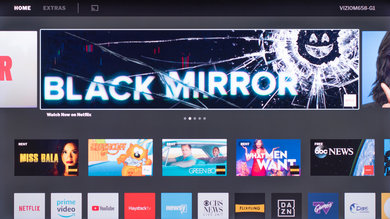Our Verdict
The Vizio M Series Quantum 2019 is a great TV for mixed usage. It delivers an impressive picture quality that's suitable for any type of content and performs well in both bright and dark rooms. Unfortunately, the viewing angles make it less ideal for those with a wide seating arrangement, but its overall performance should satisfy most people. Additionally, it has an exceptionally low input lag for those who want to game or use it as a PC monitor.
- Deep, uniform blacks.
- Impressive color gamut.
- Excellent low input lag.
- Mediocre dirty screen effect (DSE).
The Vizio M Series Quantum 2019 is a great TV for watching movies. With its full array local dimming feature and outstanding contrast ratio, this TV can produce deep inky blacks, which is great for watching movies in a dark room setting. It also has good upscaling performance for lower resolution content and remarkable motion handling to keep the picture crisp during fast-moving scenes.
The Vizio M Series Quantum 2019 is good for watching TV shows in a bright living room. It has great reflection handling and great peak brightness with SDR content, so glare shouldn't be an issue. Unfortunately, the image degrades at an angle, and older, lower resolution shows aren't upscaled as well as on other TVs.
The Vizio M Series Quantum 2019 is a good TV for watching sports, as it has outstanding motion handling that keeps the picture clear during fast-paced moments. However, the TV has some dirty screen effect that may be distracting for some, and the narrow viewing angles make it less ideal for watching with a group of friends.
The Vizio M Series Quantum 2019 is an excellent TV for gaming. Although the refresh rate is limited to 60Hz, it has a remarkably low input lag and outstanding motion handling. Unfortunately, it doesn't support FreeSync variable refresh rate and doesn't have an 'Auto Low Latency' mode. However, the exceptional black uniformity of this TV makes it a great choice for dark room gaming.
The Vizio M Series Quantum 2019 is a great TV for watching movies in HDR. It has an impressive contrast ratio and good local dimming feature. This TV also has an impressive color gamut. Unfortunately, it only has decent peak brightness in HDR.
The Vizio M Series Quantum 2019 is an excellent TV for HDR gaming. It has outstanding low input lag and an excellent response time, for a responsive gaming experience. It also looks amazing in a dark room, due to the impressive contrast ratio, outstanding black uniformity, and good local dimming feature. This TV also has an impressive color gamut, but only decent peak brightness in HDR, although most games have an option to adjust the game to match the TV's peak brightness.
The M Series Quantum 2019 is a great TV for use as a PC monitor. It has outstanding low input lag for a responsive desktop experience, and it has an excellent response time, so there's very little blur behind fast-moving objects. This TV can also display proper chroma 4:4:4 in any of the supported modes. Unfortunately, the image degrades at an angle.
Changelog
- Updated May 21, 2020: Converted to Test Bench 1.5.
- Updated Feb 21, 2020: Converted to Test Bench 1.4.
- Updated Jul 26, 2019: Review published.
- Updated Jul 24, 2019: Early access published.
Check Price
Differences Between Sizes And Variants
We tested the 65" M Series Quantum 2019, version M658-G1, and we expect our results to be valid for the 55" (M558-G1) model as well.
If someone comes across a different type of panel or if their M Series Quantum 2019 doesn't correspond to our review, let us know and we will update the review. Note that some tests, such as the gray uniformity, may vary between individual units.
Update 11/19/2019: Vizio has split their M-Series lineup into three tiers (M6, M7 and M8). We've tested the M7 variant, and we expect it to be very similar to the M6 variant. See our M7 Series Quantum 2019 review for our full results.
| Size | Model | Series | Peak Brightness | Dimming Zones |
| 55" | M558-G1 | M8 | 600 | 90 |
| 65" | M658-G1 | M8 | 600 | 90 |
We don't know the manufacturing date of our M658-G1, but the label is available here.
Popular TV Comparisons

The M Series Quantum 2019 is a great TV, and outperforms many similarly-priced models. See our recommendations for the best TVs, the best 4k TVs, and the best 4k gaming TVs.
The Vizio M Series Quantum 2019 and the TCL 6 Series 2018 are very similar overall. The M Series has a better local dimming feature and much better black uniformity, so it's a better choice for a dark room. The 6 Series is a lot brighter and has an optional motion interpolation feature.
Overall, the Vizio M Series Quantum 2019 is a bit better than the Vizio M8 Series Quantum 2020. The M Series Quantum 2019 has a better contrast ratio and local dimming, faster response time, and significantly better black uniformity. However, if you're planning on playing video games, the M8 Series Quantum 2020 has much lower input lag and variable refresh rate support.
The Vizio M Series Quantum 2019 is a bit better than the Hisense H8G. The Vizio displays deeper blacks and its local dimming feature is better. It also produces a much wider color gamut, has better out-of-the-box color accuracy, and the response time is quicker. Meanwhile, the Hisense gets brighter, it upscales lower resolution content better, and the built-in Android TV is easier to use and it has apps available to download.
The Vizio M Series Quantum 2019 is slightly better than the Vizio M7 Series Quantum 2019. The M Series (M8) has more local dimming zones and slightly better contrast ratio and delivers deeper blacks in a dark room, which is important when watching movies or HDR movies. The M7 has just slightly better reflection handling which is important in brighter rooms with many lights.

We buy and test dozens of TVs yearly, taking an objective, data-driven approach to deliver results you can trust. Our testing process is complex, with hundreds of individual tests that take over a week to complete. Most of our tests are done with specially designed test patterns that mimic real content, but we also use the same sources you have at home to ensure our results match the real-world experience. We use two main tools for our testing: a Colorimetry Research CR-100 colorimeter and a CR-250 spectroradiometer.
Test Results

The Vizio M Series Quantum is a mid-range 4k Vizio TV, and it directly replaces the Vizio M Series 2018. It's available in three variants: the M7 variant, the M8 variant, and a Black Friday variant known as the M6. The M Series Quantum's main competitors are the Samsung RU8000, Sony X850F, and LG SM8600.
The back of the TV is a mix of metal and hard plastic, and the inputs are located on the left along with the TV's controls. The inputs are easy to access, even when the TV is wall-mounted.
Unfortunately, there's no cable management.
The M Series Quantum has an outstanding native contrast ratio, similar to the Vizio V Series 2019. This results in excellent deep blacks, great for dark-room viewing. With local dimming enabled, the contrast ratio is boosted significantly, similar to the Samsung Q70/Q70R QLED.
The local dimming feature on the M Series is good. It can struggle a bit with fast-moving objects, as the backlight tries to keep up from zone to zone, causing the object's leading edge to look dimmer. Smaller objects can also appear dimmer, but blooming is kept to a minimum and you shouldn't notice significant brightness change when using subtitles.
Higher settings on the TV cause the TV's overall brightness to increase. Although we normally recommend the 'Medium' setting, it might be too bright for some environments, in which case the 'Low' setting might be better.
The M7 Series Quantum 2019 variants have a slightly worse local dimming feature, with fewer dimming zones.
The Vizio M658-G1 has great peak brightness, but it isn't quite as bright as the M Series 2018. There's some variation in brightness with different content (ABL), but it shouldn't cause any issues for most people.
We measured the peak brightness after calibration, with the 'Calibrated Dark' Picture Mode, and the Color Temperature set to 'Normal'.
The local dimming feature affects the TV's peak brightness, and higher settings result in a higher peak brightness. We measured the peak brightness with the Active Full Array setting on 'Medium'. Lower settings result in a lower peak brightness, so you may need to adjust this setting depending on your viewing conditions. The 'High' setting resulted in a dimmer image with some real content.
If you prefer a brighter image, or a colder color temperature over an accurate one, with the 'Vivid' Picture Mode and the 'Cool' Color Temperature, we measured a peak brightness of 634 cd/m² for a short period of time, as measured on the 10% test window.
The M7 Series Quantum 2019 variants have a slightly lower peak brightness.
Decent peak HDR brightness, slightly worse than last year's models.
We tested the HDR peak brightness with no calibration settings, using the 'Calibrated Dark' Picture Mode, with the Backlight set to '50'.
The local dimming feature affects the TV's peak brightness, and higher settings result in a higher peak brightness. We measured the peak brightness with the Active Full Array setting on 'Medium'. Lower settings result in a lower peak brightness, so you may need to adjust this setting depending on your viewing conditions. The 'High' setting resulted in a dimmer image with some real content.
If accuracy isn't as important to you, or if you prefer a colder color temperature, the 'Vivid' Picture Mode hit a peak brightness of 581 cd/m² for a short period of time, with the Backlight set to '100', Color Temperature set to 'cool', and local dimming on 'High'.
The M7 Series Quantum 2019 variants have a slightly lower peak brightness.
The viewing angles on the Vizio M Series are disappointing. Like most VA panels, images look washed out when viewed from an angle and there's significant color shifting. Unfortunately, it doesn't have the Enhanced Viewing Angle that Vizio implemented in its Vizio P Series Quantum X 2019.
The M Series Quantum 2019 has great reflection handling. Bright light sources aren't completely diffused across the screen, so bright lights or windows opposite the TV can still be distracting. This TV has much better reflection handling than the TCL R625.
With our pre-calibration settings, the M Series Quantum 2019 has good accuracy. Gamma mostly follows the target curve, but some really bright scenes are noticeably over-brightened. There are some minor inaccuracies in colors, but most people won't notice anything. The color temperature is warm, giving the white point a slight red-yellow tint.
After calibration, this TV has excellent accuracy. Gamma follows the target perfectly, with almost no variation from 2.2. Color errors are almost completely corrected, and any remaining inaccuracies are completely unnoticeable. The color temperature is extremely close to our target of 6500 K, and the white balance is essentially perfect.
You can see our recommended settings here.
4k content is displayed perfectly, with no pixel issues or sub-pixel dimming. Unlike the higher-end Vizio TVs, like the Vizio P Series Quantum X 2019, there's no Enhanced Viewing Angle feature, so there's no spatial dithering.
The Vizio M Series Quantum 2019 has an impressive color gamut, one of the widest we've ever measured.
The EOTF doesn't follow the PQ Curve very well. Darker scenes are displayed accurately, but it starts tone mapping very early, and all scenes above around 100 cd/m² appear darker than they should be. In 'Game' mode, the backlight defaults to '100', which causes the EOTF to display darker scenes brighter than they should be, as shown by this EOTF. With the backlight set to '50', the EOTF more closely tracks the PQ curve.
If you find HDR too dim, changing the Backlight to '100' results in a brighter image, as shown by this EOTF. If you want an even brighter image, decreasing the gamma will probably improve the brightness a bit more, but we don't expect it to impact the apparent brightness as much as the backlight setting.
This TV has great color volume; again, one of the best we've tested. It can't quite fill out its color gamut, but can display most colors at any brightness level, including dark, saturated colors.
The M Series Quantum has great gradient handling. There's some noticeable banding in most colors, but it isn't very noticeable. Unfortunately, there's no smooth gradation feature to improve gradients.
There are no signs of temporary image retention on the M Series Quantum 2019, even immediately after displaying our high-contrast static test image for 10 minutes.
We don't expect VA panels to experience permanent image retention, as the VA panel in our long-term test appears immune.
This TV has an excellent response time. There's some slight overshoot in most transitions, but this isn't very noticeable. There are duplications in motion, as seen in the above photo, due to the flicker of the backlight.
The M Series Quantum 2019 uses PWM to dim its backlight, and there's flicker at all backlight levels below 100. The 480Hz flicker is identical to last year's M Series 2018, but behaves very differently from the 120Hz flicker on the Vizio P Series Quantum X 2019. This high flicker frequency does cause noticeable duplications in motion, which can be seen in our response time photo.
This TV has an optional black frame insertion feature which can improve the appearance of motion. When enabled, this feature reduces the backlight flicker frequency to 60Hz, which helps to reduce the amount of persistence blur. This results in more noticeable duplications in motion.
Unfortunately, this TV doesn't have a motion interpolation feature.
Due to the TV's fast response time, there's some noticeable stutter when watching 24p content, like movies. This is especially noticeable with slow-panning shots.
The M Series Quantum 2019 can remove judder from 24p sources and from the native apps, as long as Film Mode is enabled. Unfortunately, it can't remove judder from 24p content sent through a 60p/i source, like a cable box.
This TV has a 60Hz panel, but doesn't support any advanced variable refresh rate features, like FreeSync or HDMI Forum's VRR feature.
The M Series Quantum 2019 has excellent low input lag, as long as Game Low Latency is enabled. Unlike many top Vizio TVs, including the Vizio P Series Quantum X 2019, there's no dedicated low latency port. Instead, all four HDMI ports have the same low latency.
See our recommended settings for gaming here.
The M Series Quantum 2019 can only support 1080p and 4k resolutions at 60Hz. For chroma 4:4:4 to be displayed properly, the Picture Mode must be set to 'Computer'. Higher bandwidth formats, like 4k @ 60Hz 4:4;4 requires that the Full UHD Color setting be enabled for the port in use.
See our recommended settings for PC gaming here.
Update 12/09/2019: Vizio has added support for HDR10+ on most 2019 and 2018 models.
This TV supports Dolby Vision from all sources.
The M Series Quantum 2019 supports ARC over HDMI port 1, but it doesn't support eARC. It can pass DTS and Dolby Digital over ARC, but for DTS to work over optical, the Digital Audio Out setting must be set to 'Bitstream'.
Decent frequency response. The low-frequency extension (LFE) is bad, resulting in very limited bass, with no thump or rumble and very little punch. The response above the LFE is good, and dialog is clear, but it lacks airiness a bit. It can get quite loud, but unfortunately, there's significant pumping and compression at louder volumes.
Decent distortion performance. The total amount of harmonic distortion (THD) produced is below 80db SPL, which is good, but it increases noticeably at max volume.
Update 11/26/2019: We've retested the TV with the latest SmartCast interface, and found it to be much faster.
The interface is visually appealing and easy to use, but unfortunately, it's not very smooth.
Like other Vizio TVs we've tested, there are no ads. There's a row of suggested content, though, on the main page, and this can't be disabled.
The remote is very basic, and is identical to the remote included with other Vizio TVs. There are a few dedicated buttons for the most popular streaming features, but the remote has no other advanced features, like voice control.











